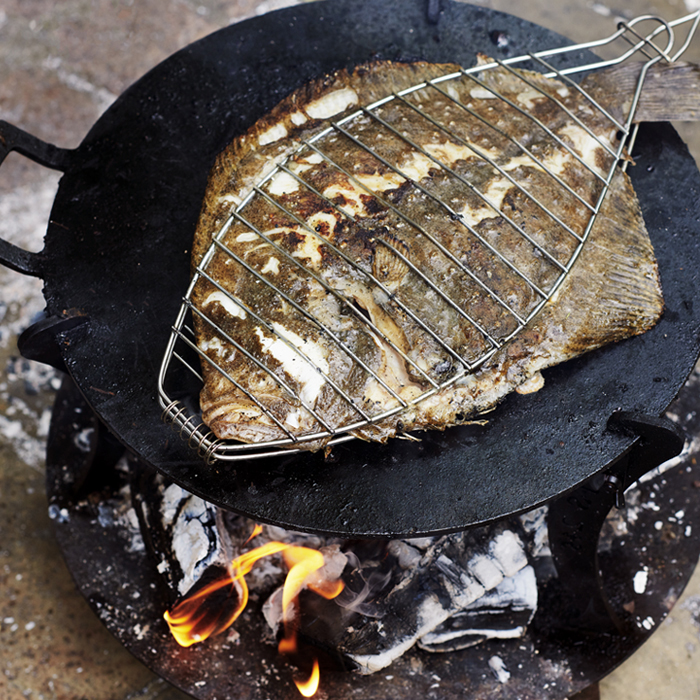A fire-cooked feast: barbecued turbot
Author: Stewart Turner

If this summer is anything like the last, the barbecue should be getting a really good workout. Cooking over an open flame has never been more popular than in recent years when we chefs have moved away from low-temperature cooking to get back the basics of man versus fire. I love cooking over open flames, imparting all that lovely flavour which at the end of the day is what it’s all about.
Most barbecue recipes concern themselves with big hunks of meat and I’m all for that, but they can be great for cooking fish and vegetables. One of my great culinary experiences last year was at Brat, a restaurant that’s signature dish is a whole grilled turbot and it was absolutely amazing, inspired by a small town in the Basque country called Getaria, where cooking is focused and very simple, and all the fish is grilled – a tradition that goes back hundreds of years.
- 1.5 kg whole turbot/brill – gutted, trimmed and cleaned
- Olive oil
- Salt
- 50ml fish stock
- 25ml white wine
- 25ml white wine vinegar
- 75ml olive oil
Dry the skin of the prepared fish, brush with oil, season with sea salt and place in a fish grilling cage. Make the vinaigrette by reducing the fish stock by half, then whisking in the wine, vinegar and olive oil.
Once you’ve lit your barbecue, let it die down a bit – you don’t want it to be too hot, as it will smoke too much. The fish will be better for a slower cook, using radiant heat – allowing the collagen in the fish to soften, making it juicy and tender, the essence of cooking whole fish.
Place the turbot or brill in its cage on the grill grate over the hot embers, cooking for five minutes per side, then brushing with vinaigrette. Continue to cook and turn every three to five minutes, brushing with the dressing as you go. Cook until you have an internal temperature of 55°C or more in the thickest part of the fish, and the skin is charred and crispy (this should take about 25 to 30 minutes, but each fire will be different).
Gently remove the fish from the cage and either take off the bone by cutting down the backbone and gently lifting off the fillets, or I personally like to leave it whole and let everyone just attack it. Finish by spooning over any remaining dressing.
What to drink: If you’re splurging on turbot, there is no point in holding back on the wine. This – the most majestic of fish – deserves something special. It’s so deliciously meaty, it deserves a white with a bit of weight or, depending how it’s cooked, a light (possibly even chilled) red. For Stewart’s Brat-inspired recipe, there are few things that would be better than white Burgundy, or top-notch New World Chardonnay. Grand Cru Chablis with a bit of age, Meursault, California’s finest or even a really good Bourgogne Blanc, it doesn’t really matter – that thrilling combination of texture, minerality and citrus will for a perfect match.
Explore our range of wines suited to the barbecue season, whatever’s on the menu.



Interesting reading, cooking a Turbot to an internal temperature of 65c is wrong & will be a dried out shadow of its former glory. It should be cooked to a maximum 50c. I accept a whole fish will take more heat because of the collagen within the bones will baste it but 65c, really….
Also, “cooked over embers” but it shows and recommends a diffuser plate. If you are going to spend serious money one one of the finest fish in the seas do not follow the temperature guidelines above
Dear Mark,
Please do accept my apologies: I’m afraid to say you spotted a crucial typo from us, it was indeed meant to be 55°C, and has now been corrected in the text. Thank you for bringing it to our attention.
Stewart has this to say regarding the specific temperature: “The stickiness you get on the turbot is the unique collagen breaking down and turning into sticky goodness. That happens at about 55ºC. If it’s too high, it’ll burn; if it’s too low, the fat won’t break down. It’s very similar to cooking pork belly: too high, it dries out; too low, it turns into rubber.”
Apologies once more for the error,
Sophie
Editor
please just make sure that your turbot is a wild one as whilst the farmed variety are now readily available they do not have the flavor of their wild cousins. the farmed are also more fatty as is the now spoilt over fatyness of farmed Salmon!
Where did you purchase the turbot grill basket from?
Dear Sophie
Regarding Stewart’s clarification on the internal cooked temperature, are these his his own words or those plagirised from the following article:
https://www.mrporter.com/en-us/journal/lifestyle/how-to-cook-fish-like-londons-hottest-new-restaurant-547672
Dear Chris,
I’m sorry, it looks like we’ve had some miscommunication on our side somewhere along the way here. Copying from other sources certainly isn’t normal practice for us. Thank you for pointing this out.
Best regards,
Charlie